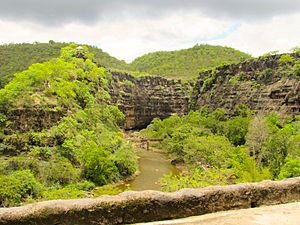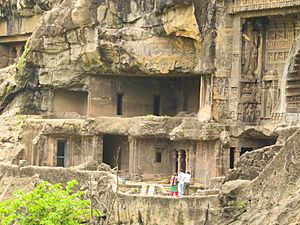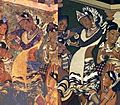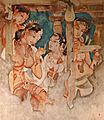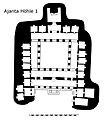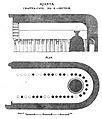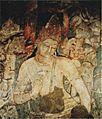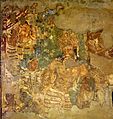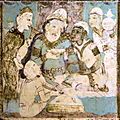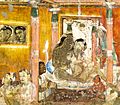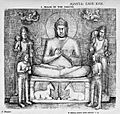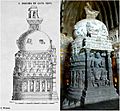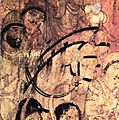Ajanta Caves facts for kids
The Ajanta Caves are a group of about 30 amazing caves found in the Indian state of Maharashtra. These caves are very old and were carved into a huge rock cliff. They are one of the most visited places in India, often explored along with the nearby Ellora Caves.
In 1983, the Ajanta Caves were named a UNESCO World Heritage site. This means they are very important to the world's history and culture. The caves are in a beautiful valley, about 4 kilometers (2.5 miles) from the town of Ajanta.
Buddhist monks lived in this valley for a long time. They were there from around 200 BCE (Before Common Era) to about 700 CE (Common Era). These monks used some of the caves as temples for worship. Other caves were used as homes or monasteries where they lived and studied. All the caves are close to a river that only flows during the Monsoon season.
Many of the most important caves at Ajanta are famous for their beautiful paintings. These paintings show stories from the life of Buddha and Buddhist teachings.
If you want to visit the caves, the closest train station is in Jalgaon, about 77 kilometers (48 miles) away. Most tours start from the city of Aurangabad, which is about 100 kilometers (62 miles) to the south. These tours often visit both the Ajanta and Ellora cave systems.
Contents
What are the Ajanta Caves?
The Ajanta Caves are a series of rock-cut caves. This means they were carved directly out of a large rock cliff. They are located in a horseshoe shape around a small river. The caves were created in two main periods. The first period was around the 2nd century BCE. The second period was much later, from the 5th to 7th centuries CE.
Who Built the Ajanta Caves?
Buddhist monks and artists created these caves. They used simple tools to carve out the rock. It must have taken many years and a lot of effort to make such detailed caves. The caves served different purposes for the monks.
Monasteries and Temples
- Many caves were viharas, which were monasteries or living quarters. Monks would live, study, and meditate in these caves. They often have a large hall with smaller rooms for the monks.
- Some caves were chaitya-grihas, which were prayer halls or temples. These halls usually have a stupa, a dome-shaped structure, at one end. The stupa was a place for worship.
Amazing Art and Paintings
The Ajanta Caves are most famous for their incredible paintings and sculptures. These artworks are some of the best examples of ancient Indian art.
What Do the Paintings Show?
The paintings mostly show stories from the Jataka tales. These are stories about the previous lives of the Buddha. They teach important lessons about kindness, generosity, and wisdom. The artists used bright colors, often made from natural minerals and plants.
Styles of Painting
The paintings at Ajanta are known for their detailed and lifelike style. They show people, animals, and plants in a very natural way. The artists used a technique called fresco-secco. This means they painted on dry plaster, not wet plaster like traditional frescoes. This allowed them to work more slowly and add more detail.
Sculptures in the Caves
Besides paintings, the caves also have many beautiful sculptures. These include statues of the Buddha in different poses. There are also carvings of gods, goddesses, and other figures from Buddhist stories. The sculptures are often found on pillars, walls, and around the entrances of the caves.
Discovery and Preservation
The Ajanta Caves were forgotten for many centuries. They were hidden by thick jungle until they were rediscovered in 1819. A British officer named John Smith found Cave 10 while hunting. He saw the entrance to the cave and explored it.
Protecting a World Treasure
Since their rediscovery, efforts have been made to protect and preserve the caves. The paintings are very delicate and have faced challenges from time, weather, and human activity. Today, special care is taken to make sure these ancient artworks last for future generations. Visitors must follow rules to help protect the caves, like not touching the paintings.
Images for kids
-
Cave 19, Ajanta, a 5th-century chaitya hall.
-
Cave 9, a first-period Hinayana-style chaitya worship hall with stupa but no idols
-
Ajanta Caves panorama with cave numbers. The caves are numbered from right to left, except for the later discovered cave 29, located high above Cave 21. Also, cave 30 is located between caves 15 and 16, nearer the river bed (cave invisible here). Chaitya halls are boxed (9, 10, 19, 26), and minor caves are indicated by a smaller type.
-
Cave 4: The Buddha in a preaching pose flanked by bodhisattvas
-
Dancing girl in Ajanta fresco; a 2012 photograph (left) and Robert Gill's 19th-century copy
-
Reproduction of The Adoration of the Buddha, cave 17, Albert Hall Museum, Jaipur, India
-
Section of the mural in Cave 17, the 'coming of Sinhala'. The prince (Prince Vijaya) is seen in both groups of elephants and riders.
-
The Bodhisattva of compassion Padmapani with lotus
-
The Buddha in long, heavy robe, a design derived from the art of Gandhara
-
Paintings of Buddhas and Bodhisattvas on the arches
-
Musician with Alapini Vina (far left), next to Indra.
-
Coin of Western Satrap Visvasena (293–304), found in the excavations at the monastery
-
Coin of Byzantine Theodosius II (402–450), found in the excavations at the monastery
-
Terracotta plaque of Hindu goddess Mahishasuramardini found on the site
See also
 In Spanish: Ajantā para niños
In Spanish: Ajantā para niños


